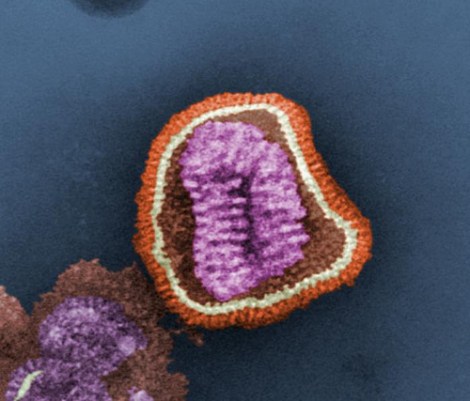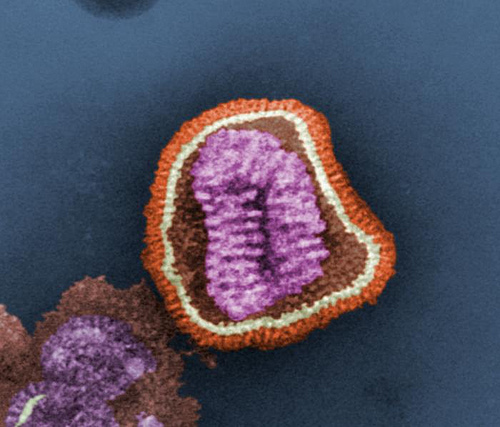In 2009, two farmers from Missouri checked into local hospitals. Each had a fever, nausea, a headache. Their blood platelets dropped severely. Doctors eventually figured out that they had a new virus, now called the Heartland virus. Transmitted by ticks, it’s only ever been seen in two people on Earth — these farmers, two men who live 60 miles apart.

This is the flu virus, not Heartland. But it’s not like you can eyeball the thing, like the tick is holding it in its hand, so this will have to do. (Photo by kat m research.)
Research on the new virus has just been published in The New England Journal of Medicine. NPR has the story:
[The Centers for Disease Control’s William] Nicholson says the new virus is in the phlebovirus family, which contains more than 70 members. And here’s another twist: Heartland virus appears to be a cousin of another new human virus called Severe Fever with Thrombocytopenia Syndrome virus, discovered last year in China. Another possible cousin may be Bhanja virus, a little-studied virus that has been found in some mammals, birds and reptiles in Asia, Africa and Europe.
Nicholson says the CDC … is looking for other people with symptoms similar to the two Heartland victims to see if they’re infected with the same virus. The researchers are also analyzing thousands of samples from Missouri ticks, other crawling insects and animals wild and domestic to see if any harbor Heartland virus.
No, this is not a script for the first five minutes of a horror movie. Unfortunately, it’s real.
Well, there’s no need to be reactionary. It’s dangerous, certainly, but neither man died, even though the illness wasn’t identified at the time. According to a LiveScience report, the symptoms are general enough that the virus may have caused other illnesses for which samples weren’t sent to the CDC. The vector isn’t certain either:
Because both men experienced tick bites shortly before they became ill — one man, a farmer, reported receiving an average of 20 tick bites a day — the researchers said it’s likely that the Heartland virus is spread by ticks, although more research is needed to confirm this.
(Frankly, I’d be more worried about the ticks than the virus.)
Unless you get bitten by ticks every hour or so and live in the Midwest, probably no real cause for concern. But there’s not much cause to be thrilled about the discovery either. Unless you’re a scientist.
“We’re pretty excited about it,” Nicholson says about the Heartland virus. “It’s not every day that you find something new — particularly in the world of tick-borne diseases. We often work with what might be considered antique diseases, such as Rocky Mountain Spotted Fever.”
Well, you have fun, Dr. Nicholson. But you’ll be one of the first ones to turn into a zombie, and I won’t have any qualms about taking you out.



